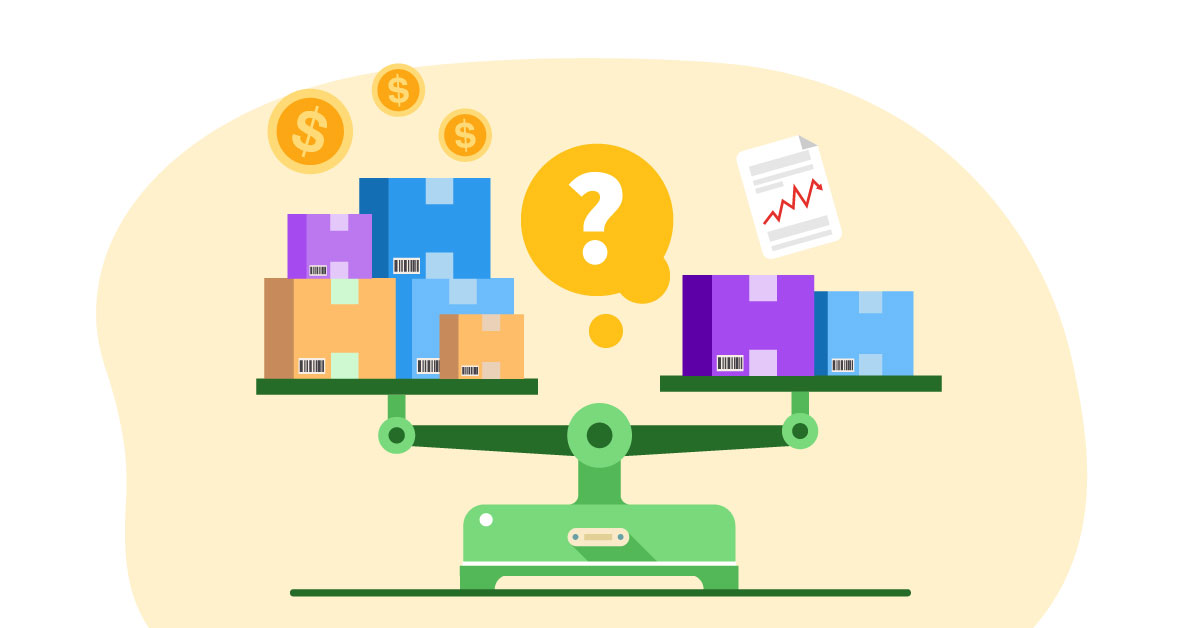
The Importance of Economic Order Quantity (EOQ) and How to Calculate It

Managing inventory is one of the most important aspects of a thriving eCommerce business, but most entrepreneurs have little experience in it when they launch. Effective inventory management can help you optimize how and when you order inventory to reduce overhead, risk, and thus total costs.
The calculation most inventory managers rely on for this is economic order quantity (EOQ), which is the order size you need to minimize risks and costs such as holding/storage, shortage, order processing, and waste. You need a considerable amount of data for this calculation, including actual costs associated with holding inventory, the likelihood of risk, and more.
Why use EOQ
Although there are dozens of inventory management equations, EOQ is a crucial one. It calculates figures such as the rate of sale, the cost of placing an order with your wholesaler or manufacturer, and delivery, processing and stocking, holding, overstock, and overselling expenses to set ideal timelines between orders.
Once you tweak the formula to fit your business, you’ll be able to minimize the amount of inventory in your warehouse at any given time. This frees up floor space and lowers the possibility of damage or being stuck with dead stock. It also cuts down the number of people needed to manage, track, and audit inventory, while making room for other types of stock.
At the same time, EOQ should balance the costs it computes with those of delivery so you reach an equilibrium. For example, if you place an order and it’s more expensive than placing a larger one and simply storing stock for longer, you need to increase the order size.
The EOQ formula
The most common EOQ formula is:
The square root of [(2 x Demand) (Sales) x Cost per order / Holding costs]
In this equation, the terms are defined as:
- Period – The span of time the calculation covers. The EOQ formula above is based on annual demand. However, you can calculate using monthly or quarterly demand as well.
- Demand – The total movement of product on a unit basis over the established time period, with calculations for peak periods, sales growth, and new business endeavors. For example, if a business has historically seen an increase in sales between 1.5% and 4% per quarter over the last five quarters, you’d calculate a 4% increase in total sales. If you know 35% of total sales occur during the holiday season, you can recalculate on a quarterly basis to adjust for it. If you’re expanding to a new channel, you can buy excess stock based on predictions for it.
- Holding costs (for the period) – The cost to store inventory per unit (carrying/storage costs, including capital, warehouse space, refrigeration, insurance, etc.). Holding costs normally increase proportionally to the quantity; for example, if you store through FBA, it’s a direct, linear rise; if you have your own warehouse, holding costs plateau at certain levels and increase at others. Actual holding expenses include computers, paperwork, software, warehouse rental, and wages. It’s important to look at the cost of warehousing per square foot and then break down inventory based on that number. If you have lots of empty space, these costs will be low. But, if you use FBA or some other third-party provider, your expenses will be significantly higher.
- Ordering cost (per order) – The cost to place an order with your supplier, including paperwork, man hours, setup, shipping costs, etc. This should be in total, not per unit.
In practice, your EOQ equation might look like this:
(2 x 1,000) x $27 / $1.12 = $219
You can then round up to $220 or down to $200 based on how your supplier sends shipments. Order frequency is simply your EOQ divided by your demand.
Challenges of EOQ
While EOQ can help you optimize total costs, it’s not perfect. In fact, it introduces complications at multiple points, including:
- Business growth – Most EOQ models incorporate the projected rate of growth into demand, usually as a sliding scale based on historic growth. That’s difficult in the early stages of scaling. Even if your business is well established and has plenty of data, making accurate projections can be complex. EOQ also has trouble predicting new growth because of market shifts, new marketplaces, competition, ad campaigns, etc. Whenever you add something new to the equation or the market shifts, your EOQ falls. So, it’s important to pay attention to real-world market behavior whenever you calculate it.
- Sales peaks – Sales peaks (normally driven by the holiday season), weather changes, and other acute events are common, but EOQ calculations usually occur on an annual basis. Taking these peaks and other unstable demand factors into account can prevent you from overstocking for most of the year and understocking during a peak period. If you have historical sales data, map expected peaks and adjust your EOQ accordingly. Peaks may be seasonal, campaign or competitor related, or due to other irregular occurrences.
- Data accuracy – You need reliable data to make reliable predictions. If you lack basic automation in your warehousing, inventory management, and order processing, you’re almost certainly missing data (for example, scanners that automatically enter SKUs into and out of inventory and consolidated data streams where stock is synchronized on a central management platform). This also holds true for supplier data, where changes in order fulfillment time, delivery availability, and other factors can greatly impact your supply chain. Having that data in real-time ensures you maintain accurate EOQ and reorder points.
Optimizing EOQ With Automation
While many organizations traditionally calculate EOQ manually, you can let technology handle the math instead. An intelligent inventory or warehouse management system will track EOQ and other calculations in near real-time. For example, JIT (Just-in-Time) inventory is an extreme form of EOQ where you minimize in-stock inventory at any given point, scheduling reorder points to arrive exactly when you sell out.
Keeping up with those numbers is all but impossible without real-time data. The algorithms make up-to-the-minute calculations based on both the current (exact) rate of sale and long-term forecasts. That’s possible when you have all of your sales points and marketplaces linked to a central inventory management system, because you see the actual rate of sale per location or warehouse, per channel, and per product. You can then track the actual rate of sale and update your EOQ on a per-order basis with the supplier.
Often, this allows you to automate reorder points either by flagging an administrator when the stock reaches a critical level or by automatically submitting the order.
Calculating EOQ for Optimal Inventory
A credible EOQ calculation takes data from every part of your business to align metrics like rate of sale, sales forecasts, and historic data with demand. Then, you can determine how many times per year you have to order and update that frequency as data changes. Granted, you’ll still have to calculate reorder points, which rely on supplier data and shipping timelines, as well as the time required to process incoming orders.
However, EOQ isn’t infallible, so you should regularly update your calculation or your order based on current, real-world data. While EOQ can be complex to figure out at first, in the long run, it can greatly reduce the inventory you have in your warehouse at any given time while preventing you from selling out.


